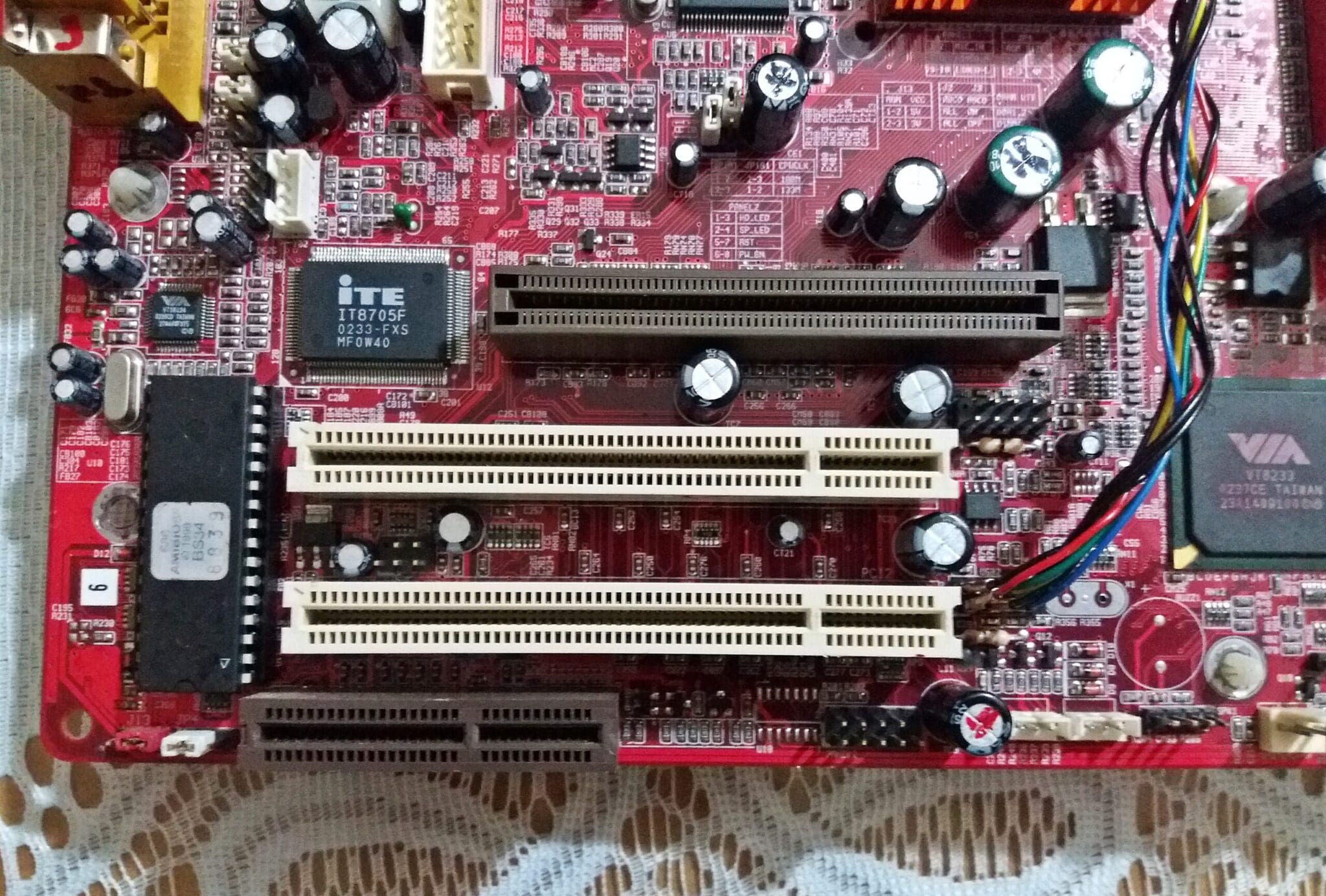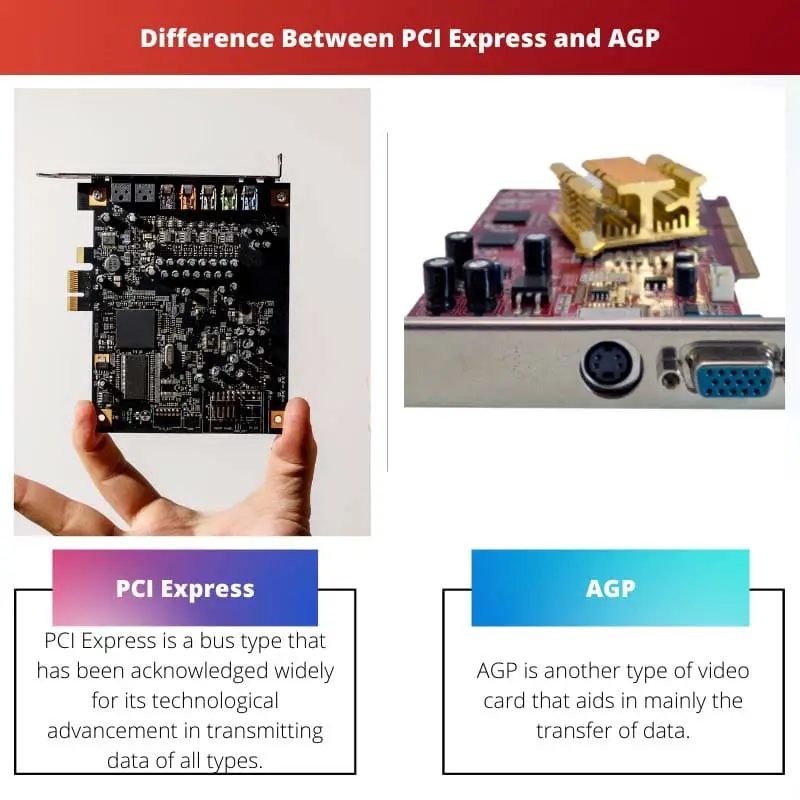PCI Express and AGP are graphic video cards used to enhance the computer’s performance. These video cards come in use primarily for gamers and online players.
Nowadays, computers do many things such as business proceedings, communications, etc. They provide faster connections to the computers and make them easier to use.
Key Takeaways
- PCI Express surpasses AGP in speed and performance, making it the preferred choice for modern graphics cards.
- AGP operates on a single, dedicated slot, while PCI Express can support multiple devices on a single bus.
- PCI Express is more versatile, as it can accommodate graphics cards and other peripherals like sound cards and network cards.
PCI Express vs AGP
PCI Express is a high-speed serial bus interface used for connecting various devices, such as graphics cards and storage devices, and was introduced in 2004. AGP is an older expansion slot primarily used for connecting graphics cards to the motherboard and was introduced in 1997.

PCI Express is a bus type acknowledged widely for its technological advancement in transmitting data of all kinds. It is not common for video cards to be able to transfer data in such an efficient manner as that of PCI Express.
Such a transmission rate has increased its sales value in the market and among professional gamers online.
AGP is another type of video card that aids in mainly the transfer of data. The data transmitted using AGP is limited to either video or a graphical form of information.
This is a huge drawback and has degraded the AGPs’ market value in the manufacturing outlets.
Comparison Table
| Parameters of Comparison | PCI Express | AGP |
|---|---|---|
| Full Form | Peripheral Component Interconnect | Accelerated Graphics Port |
| Speed in Transferring | Fast | Comparatively slow |
| Components | Isolated | Joined |
| Can Transfer All Forms of Data | Yes | No, only graphical |
| Common Slot Color | White or other colors | Brown |
What is PCI Express?
PCI Express stands for Peripheral Component Interconnect, which is additional hardware added to a computer system to aid gamers or help transfer data.
Users most commonly buy PCI Express to increase the efficiency of the data-transferring capacity of the system.
This is a bus that is connected to a computer externally through slots. This connection helps associate the user’s personal computer with a network of similar personal computers.
Such networks prove helpful in transferring data within a network or related systems that might all belong to a specific business unit or a company.
A person can share all the data that resides in their computer with others, irrespective of the nature of the data. This means that the data could be videos, photos, documents, or any other form, and could be shared without hassle.
A PCI Express is an upgraded version of the older PCI bus and has come along with many technological improvements.
PCI Express is not a part of a similar technology that allows the transfer of data in only one direction and doesn’t allow the data to be transferred in two or more rules, causing bandwidth congestion and delaying the data transfer.
PCI Express is created by serial technology that allows all forms of information and data in multiple directions. This efficiently reduces the data traffic in the given bandwidth for each specific device.
PCI Express is considered faster than most video cards that help transfer data.
The card in its exterior assembles many components that are not precisely joined to create a single piece of hardware. This can also be explained as the details are not connected or joined to the slot.
The space between the bracket and the connector is limited and therefore limits the number of devices that could be connected. Only devices with slim connection cables can be combined between the connector’s space and bracket.
Another great advantage of PCI Express is that it fits into slots that are either perfectly its size or on places that are bigger.
The data transmission speed is high for PCI Express as it has lower data traffic with more considerable bandwidth. The highest rate that it can go at is 16x.

What is AGP?
AGP stands for Accelerated Graphics Port. This name shows that they mainly deal with graphical data and their similar type of data transfer.
It was primarily in use during the 2000s as there began a rise in demand for graphic or 3D-video cards that could be useful for online gamers.
These video cards turned out to be in highly demand among the gaming community and even the general population to help create a highly efficient data transfer system.
The reason for such demands, specifically among gamers, was to help themselves cope with the newly introduced games, primarily either graphical or in 3D format.
AGP doesn’t transfer files other than video or even 3D form data containing ones. The card can be seen as a single unit, as each component is fixated onto the slot and not individually separated.
The physical distance between the connector and the bracket in an AGP card is quite large,; therefore, this is instrumental in allowing any device with small or big cables to be easily connected to the AGP.
Intel and the ownership initially developed AGP was later transferred. The speed of data transfer is small, and the number of rates is 4, with the highest being 8x.

Main Differences Between PCI Express and AGP
- While AGP deals with the data transfer of graphical and 3D format files alone, PCI Express can transfer all kinds of data including photos, videos, and documents.
- PCI Express has a huge data transfer speed with the maximum being 16x as this is facilitated by the large bandwidth, whereas in AGP, the data transferring speed is quite low as their allotted bandwidth is limited.
- The outer card in the case of AGP is a single unit and is all joined to the slot while that of PCI Express is a bunch of isolated components.
- PCI Express cards can fit into slots that are either their correct size or even into bigger slots as the hardware is advanced and has better properties whereas, on the other hand, AGP can only fit into its designated slots.
- The distance between the bracket and connector in AGP is quite large while that in PCI Express is small.

- https://users.cs.jmu.edu/abzugcx/Public/Student-Produced-Term-Projects/Computer-Organization-2004-SPRING/AcceleratedGraphicsPort-by-Patrick-Curtin-James-Dieteman-Christopher-Sanford-2004-Spring.doc
- https://link.springer.com/content/pdf/10.1007/s10586-013-0280-9.pdf

This is such a well-written and informative article. I’ve gained a lot of knowledge after reading this. Kudos to the writer!
This article provides such a comprehensive overview. Very detailed and the comparison is excellent.
This article brings a lot of good information. The comparison table is very useful and informative.
You’re absolutely right, Yvonne26! The details about the two cards are very clear and easy to understand.
The writer must be highly knowledgeable in this subject. The technical details are outstanding.
PCI Express is definitely the way to go. AGP seems so outdated now. Thanks for this informative article.
Well, I still have a soft spot for AGP but yes, the article makes a strong case for PCI Express.
PCI Express: the new generation! The convenience and speed it offers are undeniably superior.
Indeed, Philip Kelly. This article certainly helps in understanding the advancements in video cards. Kudos to the author!